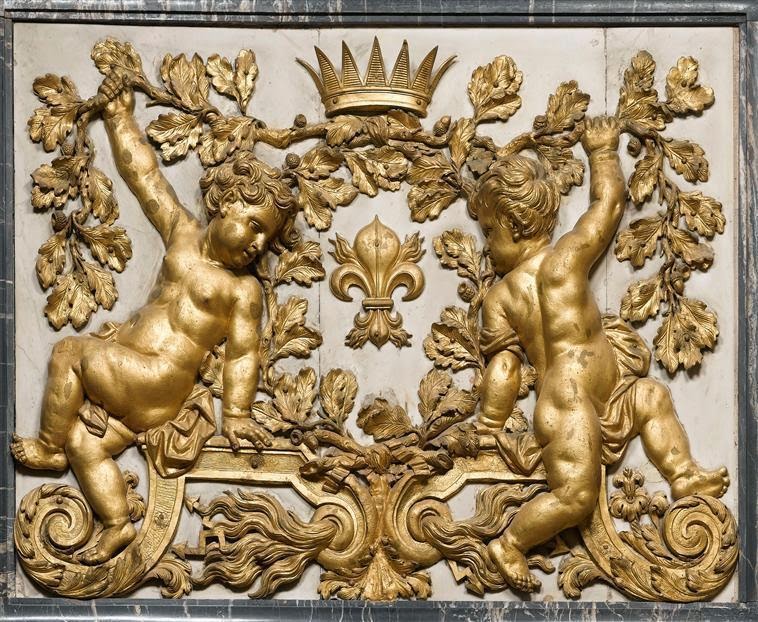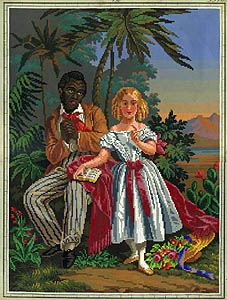Collection of Antique gold leafed frames I bought at this months estate sale displayed on powdery blue silk fabric I also bought.
This month’s estate sale was a fabulous sale. I got everything I wanted on the first day and the things I waited for on 60% off day, Sunday plus a few items more that I don’t remember seeing. Each month this sale have over twenty thousand items to look at. I try to look at each table twice or more so that I don’t miss anything but sometimes I still do only to discover it on Sunday the last day of the sale and best day of the sale because the items are 60% off the price. I was late getting this post out because this Friday is the start of the Dec estate sale. I’m already getting excited.
Detail of two of the Frames I bought at the sell. The outer frame is 18th century French 22c gold leaf and the inner frame is American lemon gold about 1840. Collection of Antique gold leafed frames I bought at this months sell. Antique "lemon gold" frames. are highly sought after for framing antique artwork today. These frames are almost always "silver gilt", meaning the leafing is done with silver leaf, and the gold color obtained by use of tinted finishes, orange in color on top of the silver leaf . The black markings often seen on antique frames occurs when the surface finish is damaged, allowing the silver leaf beneath the finish to oxidize.
I don’t remember seeing this sweet French Napoleon lll 22c gold leaf frame on Friday. But on Sunday, priced at $10. my cost would be just $4. As I held the frame trying to decide what I could put in it. It downed on me that it was the perfect size to display Antique paper money in Grand Fashion. Then I thought that I have some Alabama Alabama
Juliet Opie Hopkins and her husband Arthur F. Hopkins gave nearly five hundred thousand dollars to the Confederate cause, that would be in the millions in today’s money. Her humanitarian efforts in behalf of Alabama soldiers were recognized by the Alabama legislature which authorized her picture to be printed on several denominations of state currenc and appears on the issues of the Alabama State Montgomery while engaged in this work, and for her service she received the thanks of the State of Alabama
Juliet Opie Hopkins (1818-1890)
Juliet Opie Hopkins was the wife of prominent Mobile businessman and political leader Arthur F. Hopkins. In June 1861, while she was in Virginia, she began organizing medical and supply services to assist sick and wounded Alabama soldiers, who at the time were not provided with adequate medical services by the Confederate Medical Department.
Her voluntary efforts grew in size and scale through the summer, as groups in Alabama sent supplies and money to assist her in her efforts. In August, she established the first of three hospitals in Richmond to provide a place of care and recovery for Alabamians. By November she had established a second, larger hospital, and a third hospital followed in the Spring of 1862. In its November 1861 session, the Alabama legislature assumed responsibility for supporting these hospitals, appointing Judge Hopkins the agent for Alabama in Virginia and Mrs. Hopkins the superintendent of any hospitals the agent might establish.
Just the establishment and continued operation of these hospitals was a remarkable achievement. It was even more remarkable for a woman to emerge in such a position of leadership and responsibility. But the most remarkable aspect of Mrs. Hopkins' work was the level of personal care and attention she and her colleagues provided. Surviving records are filled with letters reflecting her efforts in behalf of the sick and wounded who found themselves in her care. All of these letters reflect a tenacious dedication to the personal care of each patient in a time when the numbers of sick and wounded tended to overwhelm and deaden the sensibilities of the people responsible for their care.
With the increasing costs and shortage by late 1863 and also the consolidation of services by the Confederate Medical Department, Mrs. Hopkins felt obligated to close her hospitals in October and to transfer her patients and supplies to the Confederate hospitals. She returned to Alabama to continue her work in hospitals in the state, serving there until the end of the War.
Mrs. Hopkins' husband died in late 1865, and Mrs. Hopkins left Alabama to live on property she owned in New York. She had lost most of her and her husband's wealth in the War and lived the rest of her life in relative poverty. She died in 1890 in Washington, D.C., in the home of her adopted daughter, also named Juliet. She was buried at Arlington Cemetery, and the members of the Alabama congressional delegation served as her pall bearers.
I was happy to buy the Berlin wool work rug early Victorian circa 1840. It is now displayed under my Classical dinning room table. Berlin wool work is a style of needlepoint. Typically it is executed with wool yarn on canvas. It was traditionally executed in many colours and hues, producing intricate three-dimensional looks by careful shading. The design of such embroidery was made possible by the great progresses made in dyeing in the 1830s.
This kind of work produced very durable and long-lived pieces of embroidery that could be used as furniture covers, cushions, bags, or even on clothing.
Berlin wool work patterns in colour were first published in Berlin, Germany, early in the 19th century. The first Berlin wool patterns were printed in black and white on paper and then hand-coloured. The stitcher was expected to draw the outlines on the canvas and then stitch following the colours on the pattern. But soon it became usual to publish counting patterns on charted paper, similar to modern cross-stitch patterns. This made it easier to execute these patterns, because there was no need for translating the patterns into actual wool colours by the stitchers themselves. They were published as single sheets mostly, which made them affordable for the masses.
Soon they were exported to Britain and the USA, where "Berlin work" became a craze. Indeed, Berlin work became practically synonymous with canvas work.
Berlin wool work rug early Victorian circa 1840.
In Britain, Berlin work received a further boost through the Great Exhibition of 1851, and by the advent of ladies' magazines such as The Englishwoman's Domestic Magazine.
The popularity of Berlin work was due largely to the fact that, for the first time in history, a fairly large number of women had leisure time to devote to needlework.
Subjects to be embroidered were influenced by Victorian Romanticism and included floral designs, Victorian paintings, biblical or allegorical motifs, and quotations such as "Home Sweet Home" or "Faith, Hope, Love".
This is a Berlin wool work mid 19th century color pattern from the famous book. “Uncle Tom’s cabin” Showing Uncle Tom and little Eva.
I use to own a Berlin wool work like this one of little Eva reading to Uncle Tom in a Arbor.
I don’t remember seeing the powder blue silk fabric on the first day. But for $4. for about 10 yards of nice silk fabric it was a very good price. Plus the color go’s well with the color on my walls in the front parlor. The fabric is displayed on a 1815 painted Baltimore
I got my book “Jane Austen's Town & Country Style” by Rizzoli. This book is a must have for anyone interested in Georgian style, furniture, decorative arts, fashion and architecture.








































































































































